In “The Most Common Backyard Birds in Oklahoma: A Comprehensive Guide,” readers will discover a wealth of information about the avian residents of the vibrant state. Drawing from the esteemed citizen science program eBird, this article offers a level of accuracy unparalleled by other similar guides. With stunning pictures accompanying each species description, readers will easily recognize backyard favorites. Beyond identification, this guide also provides valuable tips on attracting these beloved birds to one’s own backyard. From the iconic Northern Cardinal to the elegant Mourning Dove and lively Blue Jay, readers will soon feel a newfound love for the feathered friends that grace the Oklahoma sky. So whether you’re a seasoned birder or a beginner with a budding interest, this article is certain to be a valuable resource for avian enthusiasts of all stripes.
State Overview of Birds and Birdwatching in Oklahoma
Oklahoma is home to a diverse range of bird species, making it a popular destination for birdwatching enthusiasts. From the tallgrass prairies in the east to the western red cedar forests in the west, the state offers a variety of habitats that attract a wide array of birds. With its strategic location along the Central Flyway, Oklahoma serves as an important stopover for migratory birds, providing ample opportunities for birdwatchers to observe both resident and visiting species.
Introduction to Birdwatching in Oklahoma
Birdwatching, also known as birding, is a popular recreational activity in Oklahoma. Whether you’re an experienced birder or just starting out, Oklahoma’s diverse bird population offers something for everyone. The state’s varied landscape, including forests, wetlands, grasslands, and lakes, provides a rich and varied habitat for both common and rare bird species. Birdwatching is not only a great way to connect with nature but also contributes to scientific research through programs like eBird, a citizen science initiative that allows birdwatchers to record and share their observations.
Importance of Backyard Birding
Backyard birding, observing birds in and around your own property, is an accessible and rewarding way to engage with birds. It not only brings the joy of birdwatching right to your doorstep but also provides valuable support to bird populations. By creating a bird-friendly habitat and offering food, water, and shelter, backyard birders can play a vital role in conserving and protecting bird species. Additionally, backyard birding offers a unique opportunity to observe bird behavior up close and personal, providing insights into their natural history and ecology.
Birdwatching Hotspots in Oklahoma
While birdwatching can be enjoyed anywhere in Oklahoma, there are several hotspots that are particularly renowned for their bird diversity. These locations attract both local and visiting bird species, providing birdwatchers with exciting opportunities for sightings. Some of the most popular birdwatching hotspots in Oklahoma include the Wichita Mountains Wildlife Refuge, Great Salt Plains State Park, Hackberry Flat Wildlife Management Area, and the Red Slough Wildlife Management Area. These areas offer diverse habitats and are known for attracting a wide variety of both resident and migratory birds throughout the year.
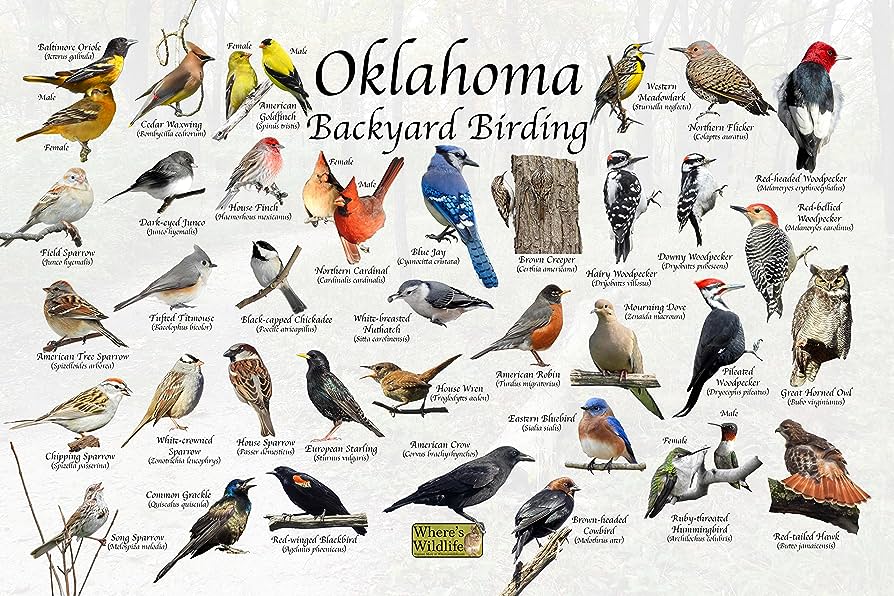
Most Common Backyard Birds in Oklahoma
Oklahoma is home to a variety of bird species, but there are a few that are particularly common in backyard habitats. These birds are well-adapted to urban and suburban environments and can often be easily spotted and identified by their distinctive characteristics and behaviors.
Northern Cardinal
The Northern Cardinal (Cardinalis cardinalis) is perhaps the most iconic backyard bird in Oklahoma. With its vibrant red plumage and distinctive crest, the male Northern Cardinal is a true showstopper. Females, on the other hand, have a more subdued brown coloration with hints of red. Cardinals are year-round residents in Oklahoma and can be found in a variety of habitats, including woodlands, gardens, and suburban areas. They are known for their melodious songs and can often be seen perched on tree branches or hopping on the ground in search of food. Northern Cardinals are ground feeders and prefer sunflower seeds, safflower seeds, and cracked corn.
Mourning Dove
The Mourning Dove (Zenaida macroura) is a common sight in Oklahoma, often seen perched on telephone wires or foraging on the ground. These medium-sized doves have a slender body, a long pointed tail, and a pinkish-gray coloration. Their mournful cooing is a familiar sound in both urban and rural areas. Mourning Doves are highly adaptable and can be found in a wide range of habitats, including forests, grasslands, and urban areas. They primarily feed on seeds, particularly those of grasses and weeds.
American Crow
The American Crow (Corvus brachyrhynchos) is a large, black-colored bird that is found throughout Oklahoma. Known for their high intelligence and adaptability, crows are often seen in both rural and urban areas. They have a stocky build and a strong, black bill. While their appearance may be simple, their intelligence and complex social behaviors make them fascinating to observe. American Crows feed on a variety of food sources, including carrion, insects, fruits, and even small mammals.
Blue Jay
The Blue Jay (Cyanocitta cristata) is a striking bird with its vibrant blue plumage, crested head, and white underparts. Blue Jays are native to Oklahoma and can be found in a variety of habitats, including woodlands, parks, and suburban areas. Their noisy calls and bold behavior make them easy to identify. Blue Jays are omnivorous and feed on a wide range of foods, including nuts, seeds, insects, and even the eggs of other birds.
European Starling
The European Starling (Sturnus vulgaris) is an introduced species that has become widespread in Oklahoma. With its glossy black plumage and speckled appearance, the starling is a distinctive bird. They are known for their loud and complex songs, often imitating the calls of other birds. European Starlings are highly adaptable and can be found in a variety of habitats, including urban areas, agricultural fields, and open woodlands. They primarily feed on insects, fruits, and seeds.
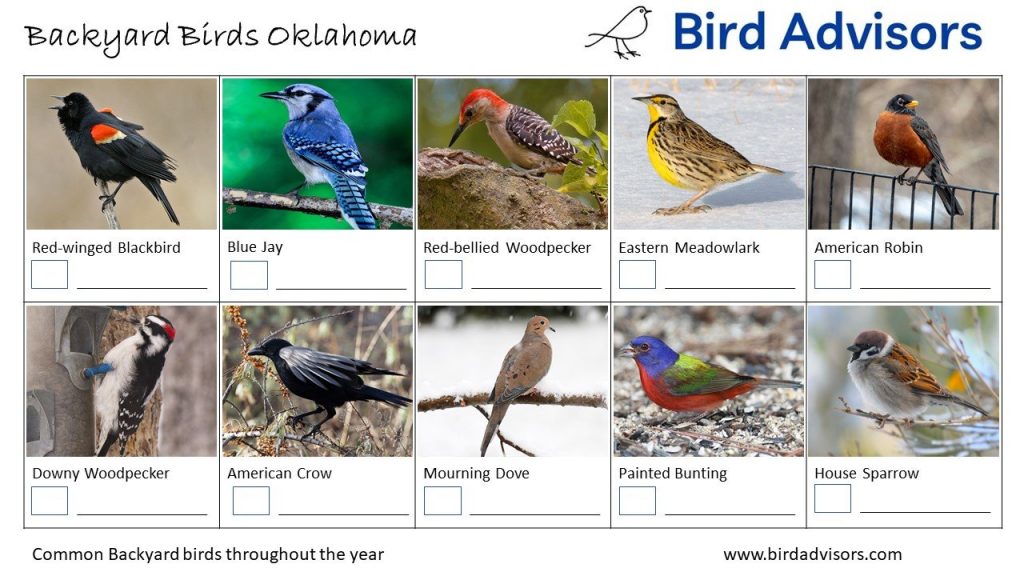
Species Accounts
Now let’s take a closer look at each of these common backyard bird species in Oklahoma. The following species accounts provide detailed information on their size, shape, bill type, color, habitat, range, behavior, and feeder preferences.
Northern Cardinal
Size and Shape
The Northern Cardinal is a medium-sized songbird, measuring about 8 to 9 inches in length. They have a stocky build and a short, strong bill.
Bill Type
The bill of the Northern Cardinal is conical in shape, perfect for cracking open seeds and fruits.
Color
Male Northern Cardinals are easily recognizable with their vibrant red plumage, black face mask, and distinctive crest. Females, on the other hand, have a more subdued brown coloration with hints of red.
Habitat
Northern Cardinals can be found in a variety of habitats, including woodlands, gardens, and suburban areas. They are often seen perched on tree branches or hopping on the ground in search of food.
Range
Northern Cardinals are year-round residents in Oklahoma and can be found throughout the state.
Behavior
These birds are known for their melodious songs, which they use for territorial defense and attracting mates. They are also highly territorial birds, defending their feeding and nesting territories vigorously.
Feeder Preferences
Northern Cardinals are ground feeders and prefer sunflower seeds, safflower seeds, and cracked corn. They are regular visitors to backyard feeders, especially during the winter months when food sources may be scarce.
Mourning Dove
Size and Shape
Mourning Doves are medium-sized doves, measuring about 9 to 13 inches in length. They have a slender body, a long pointed tail, and a small head.
Bill Type
The bill of the Mourning Dove is short and straight, adapted for feeding on seeds.
Color
Mourning Doves have a pinkish-gray coloration with lighter underparts. They have a distinctive black spot on their necks.
Habitat
Mourning Doves can be found in a wide range of habitats, including forests, grasslands, and urban areas. They are often seen perched on wires or foraging on the ground.
Range
Mourning Doves are year-round residents in Oklahoma and can be found throughout the state.
Behavior
These doves are known for their mournful cooing, which can often be heard in the early morning and evening. They form monogamous pairs and can often be seen perched together.
Feeder Preferences
Mourning Doves primarily feed on seeds, particularly those of grasses and weeds. They can often be seen feeding on the ground or perched on elevated surfaces near bird feeders.
American Crow
Size and Shape
The American Crow is a large bird, measuring about 16 to 21 inches in length. They have a stocky build and a broad wingspan.
Bill Type
The bill of the American Crow is strong and slightly curved, perfect for tearing into various food sources.
Color
American Crows have a completely black plumage, which can appear glossy in certain light conditions.
Habitat
American Crows are highly adaptable and can be found in a variety of habitats, including rural and urban areas. They are often seen perched on tree branches or foraging on the ground.
Range
American Crows are year-round residents in Oklahoma and can be found throughout the state.
Behavior
These birds are highly intelligent and are known for their problem-solving abilities. They form large social groups and often engage in communal roosting and foraging behavior.
Feeder Preferences
American Crows have a diverse diet and feed on a variety of food sources, including carrion, insects, fruits, and even small mammals. While they may not visit traditional bird feeders, they can be attracted to feeding stations with suet or other high-energy foods.
Blue Jay
Size and Shape
Blue Jays are medium-sized birds, measuring about 9 to 12 inches in length. They have a robust build and a medium-length tail.
Bill Type
The bill of the Blue Jay is stout and slightly hooked, ideal for cracking open nuts and seeds.
Color
Blue Jays are easily recognizable with their vibrant blue plumage, white underparts, and black facial markings. They also have a distinct crest on their heads.
Habitat
Blue Jays can be found in a variety of habitats, including woodlands, parks, and suburban areas. They are often seen perched on branches or hopping on the ground in search of food.
Range
Blue Jays are year-round residents in Oklahoma and can be found throughout the state.
Behavior
These birds are known for their loud and varied vocalizations, including mimicry of other bird calls. They are also highly intelligent and are known to cache food for future consumption.
Feeder Preferences
Blue Jays have a varied diet and feed on a wide range of foods, including nuts, seeds, insects, and even the eggs of other birds. They can be attracted to bird feeders with sunflower seeds, peanuts, or suet.
European Starling
Size and Shape
European Starlings are medium-sized birds, measuring about 7 to 9 inches in length. They have a stocky build and a short tail.
Bill Type
The bill of the European Starling is slender and pointed, ideal for probing into the soil or cracks to find food.
Color
European Starlings have a glossy black plumage with speckles of purple and green. During the breeding season, their feathers take on a more iridescent appearance.
Habitat
European Starlings are highly adaptable and can be found in a variety of habitats, including urban areas, agricultural fields, and open woodlands. They are often seen foraging on the ground or perched on tree branches.
Range
European Starlings are introduced species in Oklahoma and can be found throughout the state.
Behavior
These birds are known for their complex songs and ability to mimic the calls of other birds. They are highly social and often form large flocks, particularly outside of the breeding season.
Feeder Preferences
European Starlings feed on a variety of food sources, including insects, fruits, and seeds. While they may not visit traditional bird feeders, they can be attracted to feeding stations with suet or other high-energy foods.
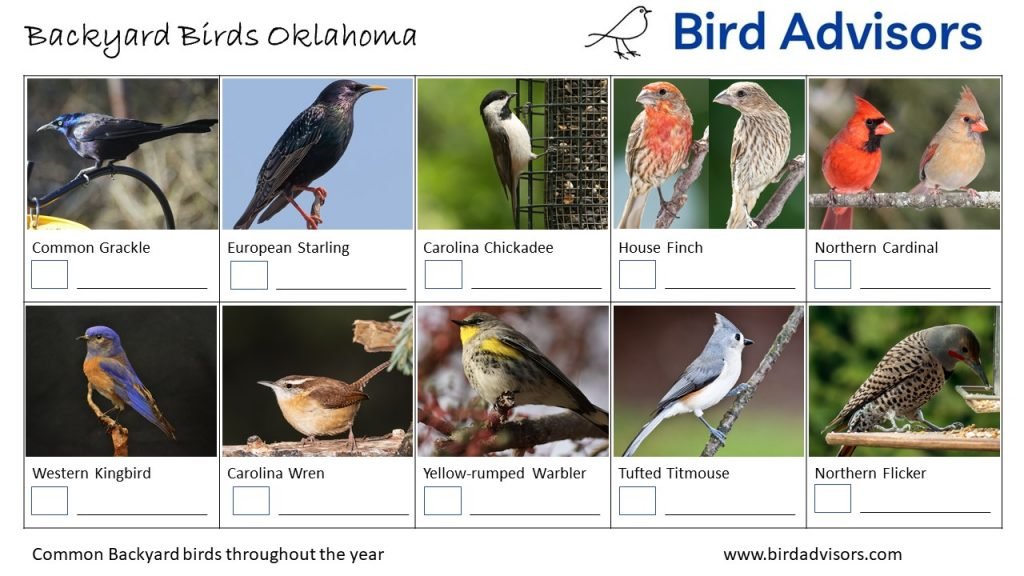
Tips to Attract Birds to Your Backyard
If you’re interested in attracting more birds to your backyard, here are a few tips to create a bird-friendly environment:
Providing Food Sources
One of the most effective ways to attract birds to your backyard is by providing a variety of bird feeders and food sources. Different bird species have different dietary preferences, so offering a mix of seeds, fruits, and insects will maximize your chances of attracting a diverse range of birds. Popular bird feeder foods include sunflower seeds, millet, cracked corn, and suet. Keep bird feeders clean and filled regularly to ensure a steady food source for your feathered visitors.
Creating a Water Feature
Birds need water for drinking and bathing, so having a water feature in your backyard can be a major attraction. A simple bird bath or a small pond can provide birds with a reliable water source. Make sure to clean and refill the water feature regularly to prevent the spread of diseases. Providing a shallow area in the water feature, such as a stepping stone or a small rock, will allow birds to safely drink and bathe.
Offering Appropriate Shelter and Nesting Sites
Birds need suitable shelter and nesting sites to feel secure and raise their young. Planting native trees, shrubs, and flowering plants in your backyard can provide birds with natural cover and nesting opportunities. Adding birdhouses or nest boxes can also attract cavity-nesting birds. Make sure to position the birdhouses at the appropriate height and orientation to ensure the safety and comfort of nesting birds.
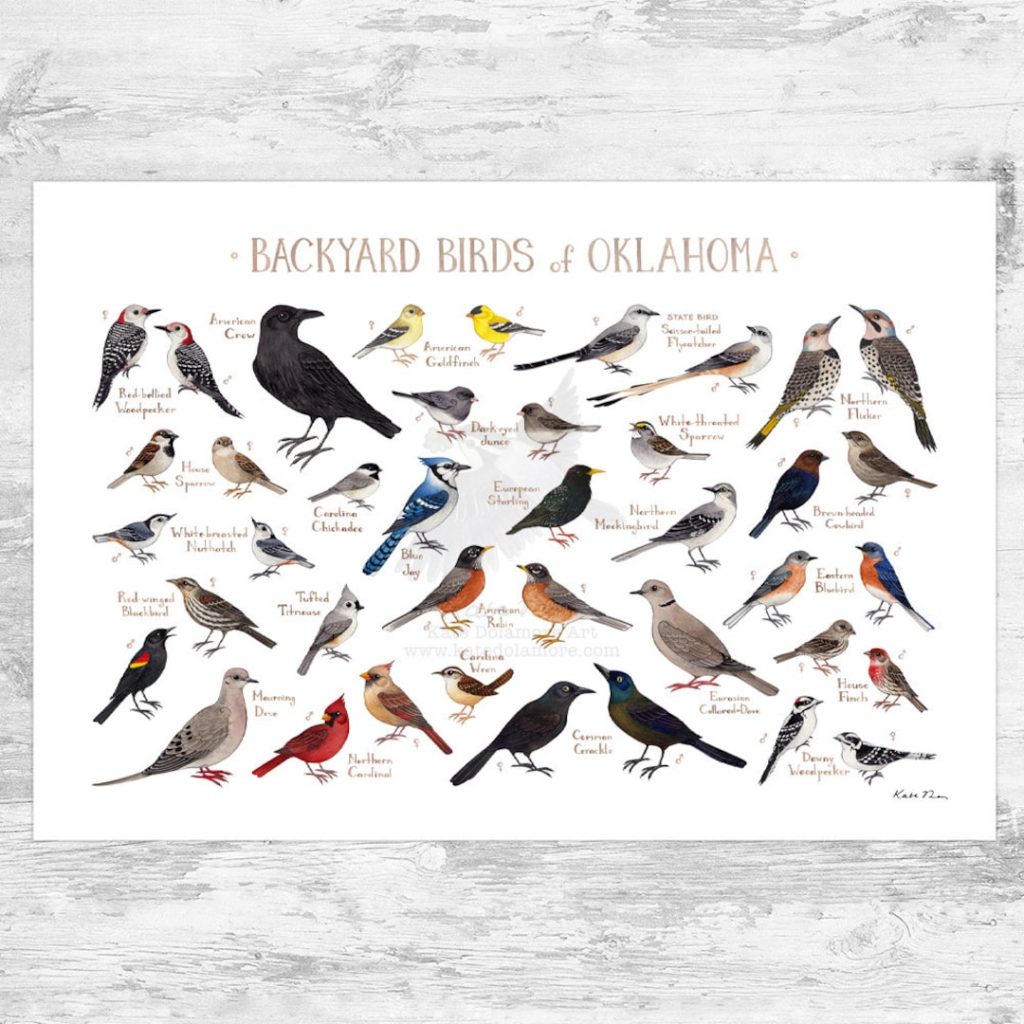
Additional Resources for Bird Identification and Bird Groups in Oklahoma
If you’re interested in learning more about birds and connecting with other birdwatchers in Oklahoma, the following resources can be helpful:
eBird
eBird is a citizen science initiative that allows birdwatchers to record and share their bird observations. The website provides an interactive platform where you can explore bird sightings, submit your own observations, and contribute to scientific research. The data collected through eBird helps researchers better understand bird populations and their distribution.
Oklahoma Ornithological Society
The Oklahoma Ornithological Society (OOS) is a non-profit organization dedicated to the study and conservation of birds in Oklahoma. The OOS provides resources for birdwatchers, including field guides, birding checklists, and information on birding events and conservation programs. They also organize field trips and birding workshops to help birdwatchers expand their knowledge and skills.
Audubon Society of Central Oklahoma
The Audubon Society of Central Oklahoma is a local chapter of the National Audubon Society. The organization focuses on bird conservation, education, and advocacy. They offer birding classes, field trips, and other events to connect birdwatchers and promote bird conservation efforts in Central Oklahoma.
By utilizing these resources and implementing the tips mentioned earlier, you can enhance your birdwatching experience and contribute to the conservation of bird species in Oklahoma. So grab your binoculars, set up your bird feeders, and get ready to enjoy the incredible diversity of birds that call Oklahoma home. Happy birdwatching!
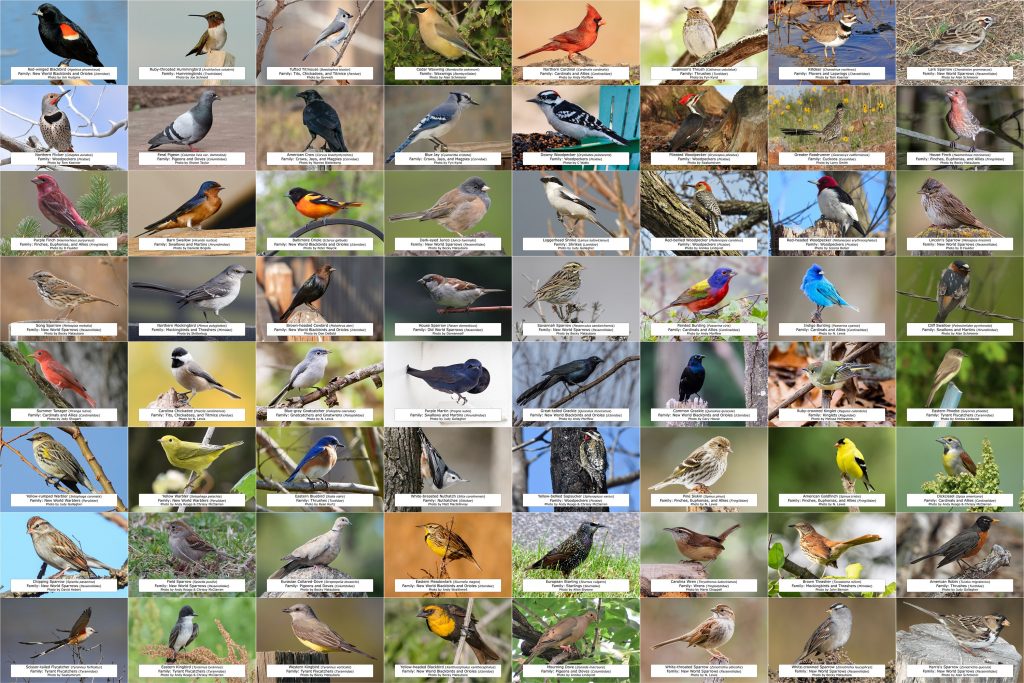
Leave a Reply